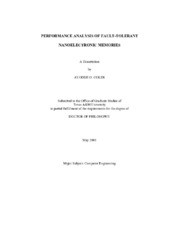| dc.description.abstract | Performance growth in microelectronics, as described by Moore’s law, is steadily
approaching its limits. Nanoscale technologies are increasingly being explored as a
practical solution to sustaining and possibly surpassing current performance trends of
microelectronics. This work presents an in-depth analysis of the impact on performance,
of incorporating reliability schemes into the architecture of a crossbar molecular switch
nanomemory and demultiplexer. Nanoelectronics are currently in their early stages, and
so fabrication and design methodologies are still in the process of being studied and
developed. The building blocks of nanotechnology are fabricated using bottom-up
processes, which leave them highly susceptible to defects. Hence, it is very important that
defect and fault-tolerant schemes be incorporated into the design of nanotechnology
related devices.
In this dissertation, we focus on the study of a novel and promising class of
computer chip memories called crossbar molecular switch memories and their
demultiplexer addressing units. A major part of this work was the design of a defect and
fault tolerance scheme we called the Multi-Switch Junction (MSJ) scheme. The MSJ scheme takes advantage of the regular array geometry of the crossbar nanomemory to
create multiple switches in the fabric of the crossbar nanomemory for the storage of a
single bit.
Implementing defect and fault tolerant schemes come at a performance cost to the
crossbar nanomemory; the challenge becomes achieving a balance between device
reliability and performance. We have studied the reliability induced performance penalties
as they relate to the time (delay) it takes to access a bit, and the amount of power
dissipated by the process. Also, MSJ was compared to the banking and error correction
coding fault tolerant schemes. Studies were also conducted to ascertain the potential
benefits of integrating our MSJ scheme with the banking scheme. Trade-off analysis
between access time delay, power dissipation and reliability is outlined and presented in
this work.
Results show the MSJ scheme increases the reliability of the crossbar
nanomemory and demultiplexer. Simulation results also indicated that MSJ works very
well for smaller nanomemory array sizes, with reliabilities of 100% for molecular switch
failure rates in the 10% or less range. | en |


